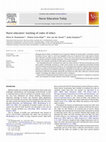Papers by Jouko Katajisto

Health Care Management Review, Mar 13, 2018
Organizations and nurse leaders do not always effectively support nurses' ethical... more Organizations and nurse leaders do not always effectively support nurses' ethical competence. More information is needed about nurses' perceptions of this support and relevant factors to improve it. The aim of the study was to examine relationships between nurses' perceived organizational and individual support, ethical competence, ethical safety, and work satisfaction. A cross-sectional questionnaire survey was conducted. Questionnaires were distributed to nurses (n = 298) working in specialized, primary, or private health care in Finland. Descriptive statistics, multifactor analysis of variance, and linear regression analysis were used to test the relationships. The nurses reported low organizational and individual support for their ethical competence, whereas perceptions of their ethical competence, ethical safety, and work satisfaction were moderate. There were statistically significant positive correlations between both perceived individual and organizational support, and ethical competence, nurses' work satisfaction, and nurses' ethical safety. Organizational and individual support for nurses' ethical competence should be strengthened, at least in Finland, by providing more ethics education and addressing ethical problems in multiprofessional discussions. Findings confirm that organizational level support for ethical competence improves nurses' work satisfaction. They also show that individual level support improves nurses' sense of ethical safety, and both organizational and individual support strengthen nurses' ethical competence. These findings should assist nurse leaders to implement effective support practices to strengthen nurses' ethical competence, ethical safety, and work satisfaction.

International Journal of Older People Nursing, Oct 30, 2020
AIMS The aim of the study was two-fold: (1) to test the psychometric properties of the Person-Cen... more AIMS The aim of the study was two-fold: (1) to test the psychometric properties of the Person-Centered care Climate Questionnaire-Patient-Finnish version (PCQ-P-Fin), and (2) to examine the associations between older patients' perceptions of the PCC climate and their perceptions of individuality in care delivered within acute care settings for older people. DESIGN An exploratory, correlational, cross-sectional survey design. METHODS The study was conducted within acute care settings for older people with heart failure (n = 111, response rate 54%). Data were collected with self-completed questionnaires, the Person-Centered care Climate Questionnaire-Patient version (PCQ-P-Fin) and the Individualized Care Scale-Patient (ICS-Patient-B), between 6/2016 and 5/2017. Data were analysed using descriptive statistics, Pearson's correlation coefficients, exploratory factor analysis and a Rasch analysis. RESULTS The PCQ-P-Fin showed satisfactory structural, construct and concurrent validity and high reliability. The ICS-B-Patient and the PCQ-P-Fin correlated strongly positive suggesting an association between the perceptions of individuality in care and the care climate. CONCLUSION The PCQ-P-Fin is a useful, reliable and valid tool. Characteristics of the care environment, especially the climate and the extent to which this is perceived to be person-centred, may be used to enhance perceptions of individualised care.

Journal of Clinical Nursing, Sep 15, 2011
Aims. The aims of this study were to explore nurses’ assessments of individualised care in long‐... more Aims. The aims of this study were to explore nurses’ assessments of individualised care in long‐term care wards and to examine how their sociodemographic variables were associated with their views of such care.Background. Although the importance of individualised care is highlighted both by nurses and by older people, there is a limited amount of research about individualised care, especially in the long‐term care of older people.Design. An exploratory design was employed.Methods. Data were collected using questionnaires [Individualised Care Scale (ICS)‐Nurse] from nurses (n = 283, n = 215, response rate 76%) working in the long‐term care wards (n = 19) of four institutions in 2009. Data were analysed statistically.Results. Overall, nurses perceived that they supported patient individuality during nursing activities but the care they provided was not so individualised. Nurses perceived that they supported older peoples’ individuality in the clinical situation and in decisional control over care well but supported older peoples’ individual life situation to a lesser extent. The higher the nurses’ age, the longer the working experience in health care or experience in the current ward, the more positive views they had about the support of individuality.Conclusions. This study identified some shortcomings in the realisation of individuality in the care of older people. Nurses seem to think they generally provide individualised care but this was not necessarily realised in the current evaluations of the care they delivered.Relevance to clinical practice. There is need to identify issues that may help in developing individualised care in clinical practice. Nurses’ attitude to older people in the geriatric care settings needs exploration. Nurses may focus on physiological needs that may hinder the recognition of older patient’s individuality.

Journal of Nursing Education and Practice, Apr 10, 2018
In nursing, research utilization (RU) is a core competence for evidence-based practice (EBP). Dur... more In nursing, research utilization (RU) is a core competence for evidence-based practice (EBP). During the past fifteen years, a great deal of effort has been expended worldwide in nursing higher education to promote EBP. This study explores graduating nursing students' RU competence in Finland using a descriptive cross-sectional, long-term survey design with two cohorts of nursing students in 2003 (n = 529) and 2012 (n = 259). Data were collected with a Competence in Research Utilization instrument, and analyzed statistically. In both cohorts, students' attitudes towards RU were positive, but their knowledge and skills were low to moderate. Students' RU competence was higher in 2003 compared to 2012. There is a need to develop nursing education strategically, and by seeking suitable pedagogical methods and curriculum contents to support the learning of RU. In higher education, educational cooperation and longitudinal learning outcome evaluations are recommended.

International Journal of Nursing Practice, Jun 19, 2017
To analyze the level of nurses' foot health and its associations with work well-being. Methods: A... more To analyze the level of nurses' foot health and its associations with work well-being. Methods: A descriptive, cross-sectional study design was applied to a random sample of Finnish nurses (n = 411). The data were collected between May 18 and June 21, 2015 using a self-administered Foot Health Assessment Instrument and analyzed using descriptive statistics and parametric tests. Results: Nurses had a variety of foot problems. Dry skin, foot pain, and corns or calluses were the most prevalent foot problems. Long-term diseases, the need for a physician's appointment due to foot problems, and decreased working ability were all associated with foot health. This finding was also supported by multivariate analysis. Conclusions: Foot problems are common among nurses and are associated with individual and work-related factors. Prevention of foot problems in nurses should be prioritized to promote their working ability and predisposing factors identified as potential intervention targets.
Journal of Advanced Nursing, Apr 6, 2020
The study was approved by the Ethical committee of the Jessenius Faculty of Medicine in Martin, C... more The study was approved by the Ethical committee of the Jessenius Faculty of Medicine in Martin, Comenius University in Bratislava (EK 2030/2017).

BMC Medical Education, Apr 22, 2021
Background: Relationships with patients are seen as the core component of establishing the qualit... more Background: Relationships with patients are seen as the core component of establishing the quality of patientcentred care and promoting patients' autonomy and relevant use of services. A clinical learning environment that emphasizes relationship-based healthcare is essential for encouraging future healthcare professionals to work in partnership with patients. There is also broad agreement that the insight of patients should be used actively in healthcare students' clinical learning. The aim of this study was to describe healthcare students' perceptions of their relationship with patients and the quality of the clinical learning environment and to identify factors associated with both of these. Methods: A cross-sectional survey using an electronic questionnaire was applied to collect data from 1644 Finnish healthcare students, mostly nursing students, between January 2018 and May 2018. The data were analysed statistically using descriptive statistics, Spearman's correlation coefficients, and multifactor analysis of variance. Results: Students perceived the level of the student-patient relationship and the role of the teacher as good while pedagogical atmosphere, premises of care, premises of learning, and supervisory relationship were perceived to be at very good level. The correlations between the student-patient relationship and all clinical learning environment dimensions were perceived as moderate. Furthermore, a number of student-related factors associated with the student-patient relationship and the quality of the clinical learning environment were detected. Conclusions: In this study, the rarely explored perspective of the student-patient relationship within the context of the clinical learning environment was included. The student-patient relationship and the quality of the clinical learning environment were perceived as good by the students, with a number of determining factors affecting these perceptions. Giving the student-patient relationship a role in clinical education may be conducive to students' learning with the patient in focus, and may thus promote the competence needed in the rapidly evolving healthcare environment and the changing scope of clinical practice.
Nursing Open
The interpersonal relationship between nurses and patients has been emphasized internationally in... more The interpersonal relationship between nurses and patients has been emphasized internationally in all areas of health care, including the education of future nurses European Patients Forum, 2020;. Moreover, the standards of patient involvement in healthcare services, with minimum requirements for person-centred care (EN 17398: 2020), challenge both professionals and educators to develop practices fostering current and future nurses to engage in partnerships with individual patients and supporting them in shared decision-making and self-care management. In clinical practicum, transformative learning and relationship-based, collaborative practices are approaches that empower nursing students to work in partnership with patients, with an aim to understand diverse determinants that affect patient health outcomes, promote patients' well-being and reduce health

on the quality of nursing care in four European countries. Methods: Data were collected in Cyprus... more on the quality of nursing care in four European countries. Methods: Data were collected in Cyprus, Finland, Greece and Sweden. The sample comprised 596 hospitalized cancer patients. The quality of nursing care was measured using the “Oncology Patients’ Perceptions of the Quality of Nursing Care Scale” (OPPQNCS). Patient characteristics were also collected. Analysis of variance was used to examine the effects of country on the perceptions of the quality of nursing care. Results: Patients’ age ranged from 18 to 86 years, and 58% were male. The comparison of cancer patients’ perceptions regarding the quality of nursing care between the four countries showed a statistically significant difference in the total OPPQNCS scores (p<0.001) as well as in the subscales responsiveness (p<0.001), individualization (p<0.001), coordination (p<0.001) and proficiency (p<0.001). The Cronbach’s alpha coefficient for the OPPQNCS ranged between 0.89 and 0.95. A multivariate analysis of var...

International Journal of Older People Nursing, 2020
AIMS The aim of the study was two-fold: (1) to test the psychometric properties of the Person-Cen... more AIMS The aim of the study was two-fold: (1) to test the psychometric properties of the Person-Centered care Climate Questionnaire-Patient-Finnish version (PCQ-P-Fin), and (2) to examine the associations between older patients' perceptions of the PCC climate and their perceptions of individuality in care delivered within acute care settings for older people. DESIGN An exploratory, correlational, cross-sectional survey design. METHODS The study was conducted within acute care settings for older people with heart failure (n = 111, response rate 54%). Data were collected with self-completed questionnaires, the Person-Centered care Climate Questionnaire-Patient version (PCQ-P-Fin) and the Individualized Care Scale-Patient (ICS-Patient-B), between 6/2016 and 5/2017. Data were analysed using descriptive statistics, Pearson's correlation coefficients, exploratory factor analysis and a Rasch analysis. RESULTS The PCQ-P-Fin showed satisfactory structural, construct and concurrent validity and high reliability. The ICS-B-Patient and the PCQ-P-Fin correlated strongly positive suggesting an association between the perceptions of individuality in care and the care climate. CONCLUSION The PCQ-P-Fin is a useful, reliable and valid tool. Characteristics of the care environment, especially the climate and the extent to which this is perceived to be person-centred, may be used to enhance perceptions of individualised care.

BMJ Open, 2019
ObjectivesThis study aims to analyse the relationship between patient education and the quality o... more ObjectivesThis study aims to analyse the relationship between patient education and the quality of surgical nursing care as perceived by patients. The background of the study lies in the importance of a patient-centred approach for both patient education and quality evaluation.DesignThis was a cross-sectional descriptive correlational study with surgical patients.SettingData were collected in 2013 in one hospital district in Finland.Participants480 hospitalised surgical patients.MethodsThe data were collected using two structured instruments: one measuring the perceived quality of nursing care experienced by patients (Good Nursing Care Scale) and one measuring the received knowledge of hospital patients (RKhp). Data were analysed statistically using descriptive and inferential statistics to describe the sample and study variables. Pearson’s correlation coefficients were used to analyse the association between the scales.ResultsSurgical hospital patients evaluated the level of the qu...

Journal of nursing scholarship : an official publication of Sigma Theta Tau International Honor Society of Nursing / Sigma Theta Tau, 2014
The purpose of the study was to explore how nurses assess their empowerment and clarify organizat... more The purpose of the study was to explore how nurses assess their empowerment and clarify organizational justice compared to other work-related factors. In addition, we examined the major variables pertinent to empowerment. Cross-sectional survey data were used. A total of 2,152 nurses returned the completed questionnaire. The instruments consisted of nurse empowerment, organizational justice, job control, and possibilities for developing work. The data analysis was based on descriptive statistics and further statistical tests. Organizational justice and empowerment had a clear correlation. Job control, possibilities for developing work and organizational justice were statistically significant predictors of nurse empowerment. Organizational justice and the possibility to use one's individual skills at work are significant factors in staff activity and its development in nursing. They increase the level of empowerment and commitment as well as motivation to work. The results of thi...

Nursing Ethics, 2008
This study aimed to describe and compare the views of nurses and older patients&amp;amp;amp;a... more This study aimed to describe and compare the views of nurses and older patients&amp;amp;amp;amp;amp;amp;amp;amp;amp;amp;amp;amp;amp;amp;amp;amp;amp;amp;amp;amp;#39; relatives on factors restricting the maintenance of patient integrity in long-term care. The purposive sample comprised 222 nurses and 213 relatives of older patients in four Finnish long-term care institutions. The data were collected using a self-developed questionnaire addressing five sets of factors relating to patients, relatives, nurses, the organization and society. The maintenance of patient integrity was restricted by: (1) social factors, including lack of respect for long-term geriatric care and lack of adequate resources; (2) patient factors relating to forgetfulness; and (3) factors relating to nurses and relatives in maintaining patient integrity. Better maintenance of patient integrity requires that more consideration is paid to issues of social respect and to the availability of adequate resources. Closer attention must be given to patients who are forgetful and unable to take part in decision making.

Nursing Ethics, 2007
This survey set out to explore occupational health professionals' courses of action with resp... more This survey set out to explore occupational health professionals' courses of action with respect to privacy in a situation of dual loyalty between employees and employers. A postal questionnaire was sent to randomly selected potential respondents. The overall response rate was 64%: 140 nurses and 94 physicians returned the questionnaire. Eight imaginary cases involving an ethical dilemma of privacy were presented to the respondents. Six different courses of action were constructed within the set alternatives proposed. The study indicated that privacy as an absolute value is not in the interest of either employees or employers. It also showed that, where dual loyalty is concerned, the most valid course of action in dealing with sensitive subjects such as drug and work community problems, sexual harassment and sick leave is to rely on tripartite co-operation. If they maintain their professional independence and impartiality, health professionals are well placed to succeed in this ...

Nurse Education Today, 2010
Although codes of ethics are thought to be an important element of nursing ethics curriculum rese... more Although codes of ethics are thought to be an important element of nursing ethics curriculum research focusing on nurses' codes is scarce and negligible in the area of education. This study explores Finnish nurse educators' teaching of codes of ethics. A total of 183 nurse educators from polytechnics providing basic nursing education in Finland answered a structured questionnaire with one open-ended question. The data was analysed statistically by SPSS and by content analysis. The responding educators' teaching of the codes was rather extensive. The focus of teaching was on the nurse-patient relationship. Nursing in a wider social context was less emphasized. Integrated teaching was the prevalent teaching format. Educators' use of teaching and evaluation methods was fairly narrow aiming at a student-centred approach. Educators' knowledge of the codes was mainly based on informal learning. The majority assessed their knowledge as adequate for teaching the codes. Educators who were motivated to build their knowledge voluntarily also taught the codes more. Educators assessed nursing students' knowledge and ability to apply the codes as mediocre. Organization of integrated teaching, objective assessment of nurse educators' competence to teach the codes, and evaluation of student outcomes need further exploring.
Journal of Nursing Care Quality, 2007
This study assessed the quality of pediatric nursing care as perceived by children (N = 388) aged... more This study assessed the quality of pediatric nursing care as perceived by children (N = 388) aged 7 to 11 in Finland. The children rated as excellent the nursing environment, the nurses' humanity and trustworthiness, and caring and communication. They were most critical about the nurses' entertainment activities such as playing with them. Children's age and type of admission were both related to the amount of information they received. The instrument used in the study needs to be developed and tested further.
JONA: The Journal of Nursing Administration, 2003
Journal of Advanced Nursing, 2004









Uploads
Papers by Jouko Katajisto